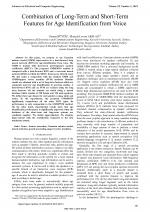| 2/2018 - 13 |
Combination of Long-Term and Short-Term Features for Age Identification from VoiceBUYUK, O. |
| Extra paper information in |
| Click to see author's profile in |
| Download PDF |
Author keywords
feature extraction, Gaussian mixture model, neural networks, speech processing, support vector machines
References keywords
processing(20), speaker(19), speech(16), recognition(14), signal(13), language(12), deep(9), verification(8), neural(8), vector(7)
No common words between the references section and the paper title.
About this article
Date of Publication: 2018-05-31
Volume 18, Issue 2, Year 2018, On page(s): 101 - 108
ISSN: 1582-7445, e-ISSN: 1844-7600
Digital Object Identifier: 10.4316/AECE.2018.02013
Web of Science Accession Number: 000434245000013
SCOPUS ID: 85047853422
Abstract
In this paper, we propose to use Gaussian mixture model (GMM) supervectors in a feed-forward deep neural network (DNN) for age identification from voice. The GMM is trained with short-term mel-frequency cepstral coefficients (MFCC). The proposed GMM/DNN method is compared with a feed-forward DNN and a recurrent neural network (RNN) in which the MFCC features are directly used. We also make a comparison with the classical GMM and GMM/support vector machine (SVM) methods. Baseline results are obtained with a set of long-term features which are commonly used for age identification in previous studies. A feed-forward DNN and an SVM are trained using the long term features. All the systems are tested using a speech database which consists of 228 female and 156 male speakers. We define three age classes for each gender; young, adult and senior. In the experiments, the proposed GMM/DNN significantly outperforms all the other DNN types. Its performance is only comparable to the GMM/SVM method. On the other hand, experimental results show that age identification performance is significantly improved when the decisions of the short-term and long-term systems are combined together. We obtain approximately 4% absolute improvement with the combination compared to the best standalone system. |
| References | | | Cited By |
Web of Science® Times Cited: 7 [View]
View record in Web of Science® [View]
View Related Records® [View]
Updated today
SCOPUS® Times Cited: 12
View record in SCOPUS® [Free preview]
View citations in SCOPUS® [Free preview]
[1] Speaker age and gender recognition using 1D and 2D convolutional neural networks, Yücesoy, Ergün, Neural Computing and Applications, ISSN 0941-0643, Issue 6, Volume 36, 2024.
Digital Object Identifier: 10.1007/s00521-023-09153-0 [CrossRef]
[2] Age Estimation from Speech Using Tuned CNN Model on Edge Devices, Durgam, Laxmi Kantham, Jatoth, Ravi Kumar, Journal of Signal Processing Systems, ISSN 1939-8018, Issue 10, Volume 96, 2024.
Digital Object Identifier: 10.1007/s11265-024-01929-4 [CrossRef]
[3] Image Retrieval using One-Dimensional Color Histogram Created with Entropy, KILICASLAN, M., TANYERI, U., DEMIRCI, R., Advances in Electrical and Computer Engineering, ISSN 1582-7445, Issue 2, Volume 20, 2020.
Digital Object Identifier: 10.4316/AECE.2020.02010 [CrossRef] [Full text]
[4] Age and Gender Estimation Through Speech: A Comparison of Various Techniques, Shabbir, Maliha, Hussain, Amjad, Khan, Maqsood Muhammad, 2023 18th International Conference on Emerging Technologies (ICET), ISBN 979-8-3503-2817-2, 2023.
Digital Object Identifier: 10.1109/ICET59753.2023.10374670 [CrossRef]
[5] Technology as Infrastructure for Dehumanization:, Oviatt, Sharon, Proceedings of the 2021 International Conference on Multimodal Interaction, ISBN 9781450384810, 2021.
Digital Object Identifier: 10.1145/3462244.3482855 [CrossRef]
Disclaimer: All information displayed above was retrieved by using remote connections to respective databases. For the best user experience, we update all data by using background processes, and use caches in order to reduce the load on the servers we retrieve the information from. As we have no control on the availability of the database servers and sometimes the Internet connectivity may be affected, we do not guarantee the information is correct or complete. For the most accurate data, please always consult the database sites directly. Some external links require authentication or an institutional subscription.
Web of Science® is a registered trademark of Clarivate Analytics, Scopus® is a registered trademark of Elsevier B.V., other product names, company names, brand names, trademarks and logos are the property of their respective owners.
Faculty of Electrical Engineering and Computer Science
Stefan cel Mare University of Suceava, Romania
All rights reserved: Advances in Electrical and Computer Engineering is a registered trademark of the Stefan cel Mare University of Suceava. No part of this publication may be reproduced, stored in a retrieval system, photocopied, recorded or archived, without the written permission from the Editor. When authors submit their papers for publication, they agree that the copyright for their article be transferred to the Faculty of Electrical Engineering and Computer Science, Stefan cel Mare University of Suceava, Romania, if and only if the articles are accepted for publication. The copyright covers the exclusive rights to reproduce and distribute the article, including reprints and translations.
Permission for other use: The copyright owner's consent does not extend to copying for general distribution, for promotion, for creating new works, or for resale. Specific written permission must be obtained from the Editor for such copying. Direct linking to files hosted on this website is strictly prohibited.
Disclaimer: Whilst every effort is made by the publishers and editorial board to see that no inaccurate or misleading data, opinions or statements appear in this journal, they wish to make it clear that all information and opinions formulated in the articles, as well as linguistic accuracy, are the sole responsibility of the author.



